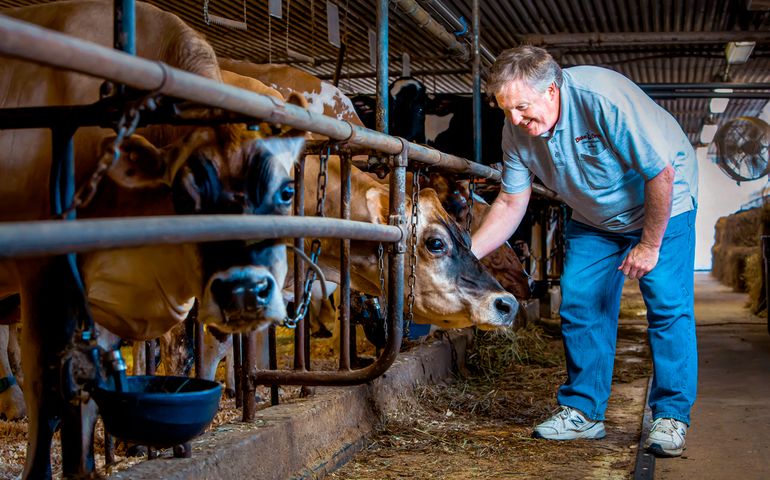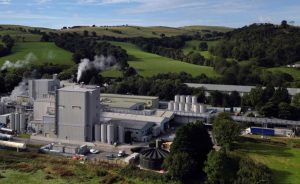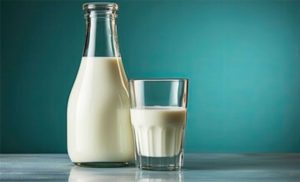“When they shut down, we lost it all,” says the operation’s co-owner, Stephen O’Brien. “It was like someone pulled the rug out from under us.”
It was March and the state had shut down nonessential businesses due to the pandemic. Three of Baker Brook’s customers remained, including MaineGeneral in Augusta. But cows aren’t well read on economic exigencies. They were still putting out nearly 10,000 gallons of milk per month.
Most of that milk was in limbo. O’Brien and his son Alan, who manages the farm, quickly worked out a plan to sell the milk at a discount to Westbrook-based Smiling Hill Farm, which regularly processes Baker Brook’s milk anyway and could use the excess for its cheese-making operation. To slow milk production, and also because they had to cut back on their monthly grain bill of $8,000 to $9,000, the O’Briens “dried off” some cows months earlier than they normally would.
Drying off involves gradually decreasing the amount of energy-rich grain in a cow’s diet that helps them produce milk. Production slowed to about 8,700 gallons per month.
The farm was fortunate to have Smiling Hill take the excess milk, says O’Brien. Still, the farm had to lay off several employees and sustained about $80,000 in revenue losses from March through May due to lack of sales through its usual channels.
“It was a struggle and still is a struggle,” he says. “But we’re resilient.”
Pre-pandemic optimism
Before the pandemic, 2020 was shaping up to be a good year for dairy farmers in Maine and across the country, says Julie-Marie Bickford, executive director of the Maine Dairy Industry Association.
Average prices were expected to rise to levels not seen in the previous five years. In 2014, the price paid to farmers per “hundredweight” (a measurement for raw milk that’s the equivalent of 100 pounds or 11.6 gallons) was $24.28. The price sank to $17.14 in 2015 and subsequently remained $15 to $18. Although the state has a stabilization program to help bridge the gap between production costs and revenue, it hasn’t kept pace.
But for 2020, the price was projected to rise to $19.86, according to an Agri-Mark forecast.
Why the expected uptick?
“A strong economy and high international demand was causing the milk price to increase in the first part of 2020,” explains Ben Taylor, co-owner of Taylor Dairy Farm in St. Alban’s and chair of Maine Dairy Promotion’s board of directors.
Instead, the pandemic’s shelter-in-place orders dried up demand for milk, cheese, butter, sour cream and other products from large buyers such as colleges, school systems and restaurants. Although many schools still delivered food to students, there is still less milk being consumed within school districts, notes Taylor. Milk consumption in the home increased as people moved to remote work and home-prepared meals, but demand for products like cheese and butter melted away, resulting in a decline in prices paid to dairy farmers. International trade of dairy products also slumped.
As of mid-June, says Taylor, prices were at $11.50 per hundredweight, well below the pre-pandemic’s $18.
“It got pretty scary for a while,” says Bickford.
Pare production
In response to the uncertain market, the regional cooperatives that manage most Maine dairy farms required them to reduce production. Taylor’s coop, Andover, Mass.-based Agri-Mark Inc., required a 4% reduction from May through June, and 2% for July.
“It doesn’t sound like much but, when you add it up, it’s a lot of milk,” says Doug DiMento, director of corporate communications for Agri-Mark (commonly known as Cabot Creamery Cooperative), which includes about 90 Maine farms and 800 overall throughout New England and New York. “It’s not good news for the dairy farmers because they need to keep their cash flow going. On the other hand, we can’t market milk there’s no home for.”
Food service is 40% of Agri-Mark’s business, says DiMento. One of the co-op’s functions is to guarantee prices and markets. The pandemic wrought havoc.
“There’s been a lot of turmoil,” he continues. “We’re trying to work through it now. We expect food service will come back a little bit. But how much? How many restaurants and hotels will open in Maine?”
Options to pare production — at a time of year when cows naturally go full bore — included drying off and culling cows, says Taylor. Drying off still incurs the expense of care with no corresponding income, but allows the farm to return to normal production when it’s allowed. Taylor’s nutritionist is also developing a feed ration that doesn’t focus solely on pounds of milk, but rather on pounds of fat and protein to develop a premium product earning a higher price.
Culling mostly consists of converting to beef cattle.
“All dairy farmers also produce for the beef market,” Bickford wrote in a June market report. “During this COVID-19 era, being able to slaughter and package dairy cows and bulls for beef has not only provided additional outlets for Maine people to secure food, but has served as another income stream for Maine dairy farms.”
Taylor’s farm sold around 30 cows over three or four weeks to try to reduce production.
“Beef prices had come up a bit so the additional beef sales did help some, but not enough to offset the lower milk prices,” he says.
Either way, less milk shipped meant lower revenues during what’s usually the most expensive time of year.
“March, April and May are three of the most cash-intensive months for dairy farms, because they’re getting ready to plant their crops,” says Bickford. “Most farmers grow the feed they give to their cattle. They have to make their purchases of feed and fertilizer, and they start repairing their equipment in those months. There just wasn’t a lot of money, so it was very unsettling for farmers.”
Prices rising again
By late June, as the economy reopened, prices started to head up again.
“The milk prices are not as low as the futures were suggesting back in April, which is good,” says Taylor. “Also, the co-op is reducing the required reduction for the month of July, which I believe is another good sign. I believe this is mostly because people are buying more dairy in the grocery stores than what was originally thought.”
Still, it’s not clear whether they’ll reach the level originally expected for 2020. And, Bickford adds, “things could just as easily plummet again if other states start re-implementing restrictions in response to rising COVID cases.”
The state’s stabilization program covers some of the industry’s losses, she says, but falls short in the current pricing environment. Production cuts imposed by co-ops is expected to deprive Maine dairy farmers of almost $5.5 million per month. And the industry already operates on razor-thin margins, she says.
Of the 212 farms open before the pandemic, seven have gone out of business. Still, she adds, that’s far fewer closings than the industry might have expected. That’s partly thanks to Maine’s processing plants and their 100% utilization of Maine milk. Also, increased fluid demand has stabilized that portion of the market.
“We hope it continues, because it will shore up the financial future for the processing plants, which will have a spinoff positive effect for our farmers,” Bickford says.
Stabilization?
“It has been pretty disruptive,” says John Bennett, president of Oakhurst Dairy in Portland, says of the pandemic’s impact on the industry. “But I think we’ve reached a little bit of stabilization.”
Oakhurst, started by Bennett’s grandfather a century ago and now owned by Dairy Farmers of America, is one of Maine’s four fluid milk-processing plants (the others are Portland’s H. P. Hood, Houlton Farms Dairy and Smiling Hill Farms). Oakhurst processes roughly 500,000 gallons per week — about 25 million gallons per year.
Ice cream is an example of shifting market dynamics, Bennett notes. As consumers stocked up on key food items, distributors worked to keep milk on supermarket shelves. Ice cream took a back seat.
“It’s not a critical item,” says Bennett. For a while, sales of cream and mixes used to make ice cream slowed considerably. It’s turning around now. Ice cream is back on the delivery trucks.
“Nothing’s come around completely to the way it was, but we’re seeing it come back up,” he says.
Despite shifting dynamics, Oakhurst’s production numbers and workforce of just under 200 remained stable through the pandemic.
“Maine is a good place to be a dairy farmer, I think, relatively speaking,” Bennett says. “I haven’t seen any drop-off because of the pandemic. But I think there’s uncertainty. People are wondering if the market is still secure. I think it is. We have demand for that milk and for the byproducts.”
Still, DiMento wonders what the future holds.
“In the fall, when school comes into session, business usually picks up,” DiMento says. “Will that happen this year? We don’t know. How will that affect our business? We don’t know. This is a new world, with the pandemic. We’ll all have to adapt and change as needed to get through this.”
Dairy details
Maine’s dairy farms range from two to 1,700 cows and use both conventional and organic methods. Except for three not-for-profit educational farms, all are family-owned and -operated.
Maine produced 617 million pounds (72 million gallons) of milk in 2019
Maine has almost 150 small processors of butter, ice cream and other value-added sidelines aimed at new markets and premium prices.
In late June, Maine dairy farmers were awarded $6.66 million in federal direct payments through the CARES Act.
Sources: Maine Dairy Industry Association, U.S. Sen. Susan Collins













